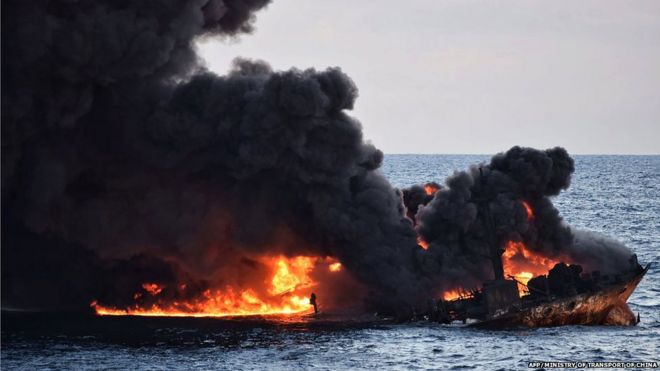You are here
'Fishing continued' after East China sea oil spill
'Fishing continued' after East China sea oil spill
Navin Singh Khadka 23 February 2018
AFP/Image caption The tanker carried a highly toxic petroleum product that became invisible after the spill . Transport Ministry of China
Fishing continued at the site of a massive oil spill in the East China Sea for days after the incident, satellite images obtained by the BBC suggest.
Most of the fishing vessels in the affected region were identified as Chinese.
There have been major concerns over possible contamination in seafood and marine life in and around the region.
The spill occurred after an oil tanker collided with another cargo ship on 6 January before sinking days later.
It was transporting 136,000 tonnes, or almost one million barrels, of ultra-light crude oil, known as condensate, to South Korea.
It is feared to be highly toxic and is invisible, unlike the shimmering slick on the sea-surface seen after crude-oil leaks.
Experts say it is the first time petroleum product of this type has spilled in such huge quantity.
Independent experts say fishing was not stopped until much later and reports in the Chinese media indicate the same.
The BBC obtained satellite images and data showing the presence of fishing boats in the area following the event.
China is a major seafood exporter and the impacted region is known to be rich in fisheries including species like crab, squid, yellow croaker, mackerel, among others.
The Chinese state oceanic administration did not respond to repeated BBC requests for comment on fishing activities.
According to the agriculture ministry website, an area of 30 nautical miles radius from the accident site was declared as a prohibited zone after the accident.
"Based on our analysis, we estimate fishing activities to have likely continued in the area since the incident occurred, including within 60 nautical miles of the sinking site," said Brad Soule, chief analyst with OceanMind, a not-for-profit organisation specialising in tracking fishing activities.
The group's analysis estimates that there were more than 400 fishing vessels operating within the region between 6 January and 25 January, while 13 were detected within 60 nautical miles of the sinking site.
Sanchi, the tanker carrying the oil from Iran, is believed to have drifted between 50 to 100 nautical miles south after the collision before it sank.
This could mean that it continued spilling the condensate all along the way before it went down.
China's Ministry of Transport said that a salvage team had located the sunken vessel at a depth of 115m (380ft).
"Between January 26 and February 14, 146 observed fishing vessels were active in the region and two observed fishing vessels active within 60 nautical miles of the sinking site," OceanMind said in its analysis.
Mr Soule said the analysis was based on transmissions received from only fishing vessels which were travelling at speeds that are associated with fishing activity, slower than typical travelling speeds.
The vessels carry communications devices called transponders that send radio signals identifying themselves.
continue...http://www.bbc.com/news/science-environment-43142538

